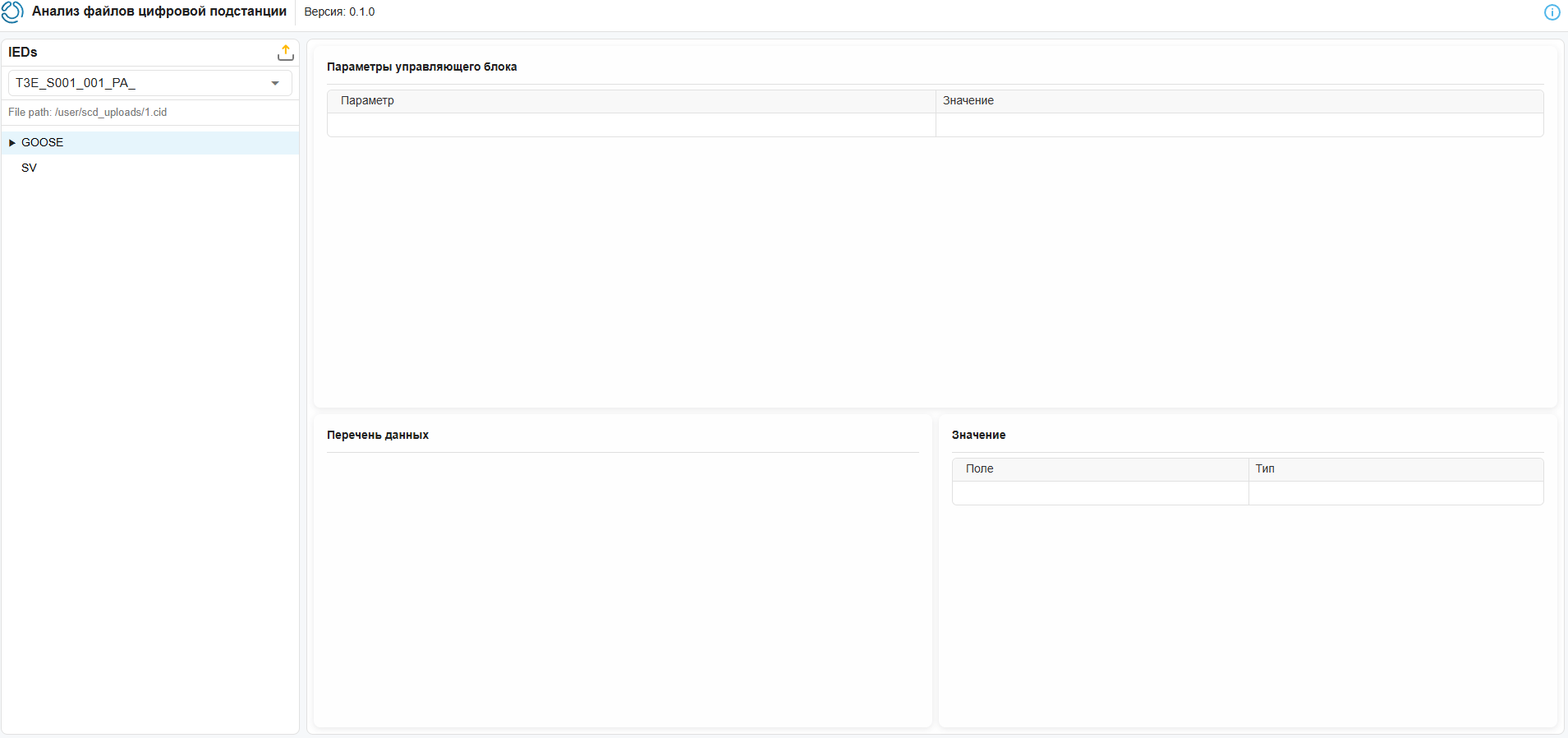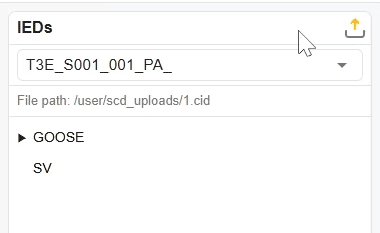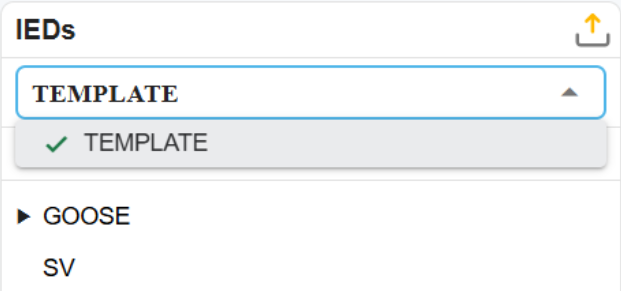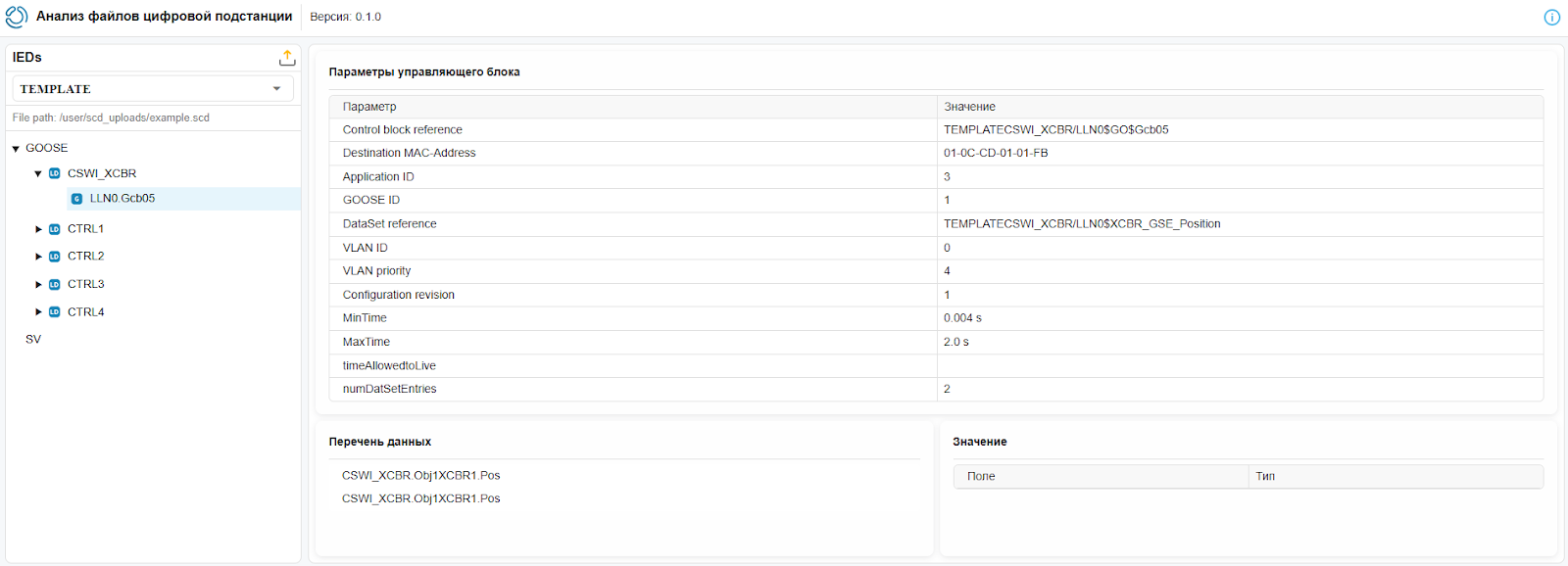File analysis of digital substation
File analysis of digital substation ![]() — This is an Engee application designed for visual analysis of configuration files of digital substations according to the IEC 61850 standard (formats: .icd, .cid, .iid, .scd, .xml, .ssd, .sed).
— This is an Engee application designed for visual analysis of configuration files of digital substations according to the IEC 61850 standard (formats: .icd, .cid, .iid, .scd, .xml, .ssd, .sed).
To open the app, go to application window Engee ![]() and select "File analysis of digital substation
and select "File analysis of digital substation ![]() The application runs in a separate browser tab and by default looks like this:
The application runs in a separate browser tab and by default looks like this:

Terms and abbreviations
General terms
| Reduction | Decoding | Description |
|---|---|---|
IED |
Intelligent Electronic Device |
Intelligent electronic device |
LD |
Logical device |
Logical device |
LN |
Logical node |
The logical node |
LLNO |
Logical node zero |
The zero logical node. A mandatory logical node in each LD. |
GOOSE |
Generic Object Oriented Substation Event |
A protocol designed to exchange event signals at a substation in digital form |
SV |
Sampled Values |
A protocol designed to transfer digitized values of analog signals such as current and voltage |
cbName |
Control Block Name |
The name of the control unit that sends GOOSE/SV messages |
DO |
Data Object |
The data object |
DA |
Data Attribute |
The data attribute |
termines of network parameters of the "Control unit parameters" table
| Parameter | Meaning | Affiliation |
|---|---|---|
Control block reference |
The full name of the GOOSE control unit, in the format: IED + LD/LLN0$GO$Name. Defines a unique path to the control unit. |
GOOSE |
Destination MAC-Address |
The destination MAC address used to send messages in a multicast group. |
GOOSE/SV |
Application ID |
The application identifier (APPID), which defines the logical relationship between the sender and the recipient. |
GOOSE/SV |
GOOSE ID |
The GOOSE ID (goID). It is often used as the logical name of a publication. |
GOOSE |
noASDU |
The number of ASDUs (Application Service Data Unit) in one APDU (Application Protocol Data Unit), that is, the number of sets of reports transmitted in one SV package. |
SV |
MsvID |
Identifier of the measured value stream |
SV |
smpSynch |
A parameter that defines the time synchronization of reports (sampling synchronization) in the SV stream. |
SV |
SmpRate |
The sampling frequency (in Hertz) with which the measuring device generates reports and generates an SV stream |
SV |
DataSet reference |
A reference to the set of data transmitted by the selected control unit. |
GOOSE |
VLAN ID |
ID of the virtual local area network (VLAN) over which messages are being transmitted. |
GOOSE/SV |
VLAN priority |
Message priority when processed by the VLAN switch |
GOOSE/SV |
Configuration revision |
The version of the block configuration. It is used to control changes in the message structure. |
GOOSE/SV |
MinTime |
The minimum time interval (in seconds) after which the message is retransmitted. |
GOOSE |
MaxTime |
The maximum time interval (in seconds) after which the message is retransmitted. |
GOOSE |
timeAllowedtoLive |
The maximum lifetime of a GOOSE message (in milliseconds). After it expires, the message is considered outdated. |
GOOSE |
numDatSetEntries |
The number of elements in the DataSet associated with the selected control unit. |
GOOSE |
Working with the app
To work with the application, you need to import a supported file format (.icd, .cid, .iid, .scd, .xml, .ssd, .sed) using the button  Upload a file:
Upload a file:

After successful file download, the application interface will automatically change.:

Next, select the desired device (IED) from the drop-down list:

This will update GOOSE and SV messages corresponding to the selected IED.
GOOSE and SV message trees
Two trees are displayed in the left panel of the application:
-
GOOSE-messages
-
SV messages
Each tree is built according to the following three-level hierarchy:
[GOOSE] / [SV]
└── LD
└── LLN0.cbName-
The first level of the hierarchy shows which type of messages the selected device has (GOOSE or SV);
-
At the second level of the hierarchy, logical devices (LD) that generate messages are represented;
-
At the third level of the hierarchy, the logical node zero (LLN0) and the name of the control unit (cbName) of the message are represented.
Working with tables
When a control unit is selected, its parameters are displayed in the "Control Unit Parameters" table, and the data objects are displayed in the "Data List" table.

The "Data List" table displays the contents of the DataSet transmitted as part of the selected GOOSE or SV message. Each element of the dataset is described in the format LD.LN.DO , indicating the source of the signal: a logical device, a logical node, and a data object.
When selecting a data object from the "Data List", the "Value /Structure" table is displayed on the right, which shows the data attributes included in the selected data object, as well as the type of each attribute.:

-
The Field column displays the name of the data attribute (DA) of the selected data object (DO).
-
The attribute type is displayed in the "Type" column.
If the data is presented as a structure during transmission, the table name will change to "Structure".
An example of how the application works
After downloading the file, the drop-down list displays all the IEDs described in the file (in this case, only the TEMPLATE), specifies the path to the file, and creates GOOSE and SV message trees. If the SV does not have a marker to disclose, it means that such messages are missing from the selected IED.

Next, go to the GOOSE protocol, expand ( Select the first logical device and select its GOOSE message. After that, the parameters of the GOOSE message with the name "Gcb05" are displayed:
Select the first logical device and select its GOOSE message. After that, the parameters of the GOOSE message with the name "Gcb05" are displayed:

The GOOSE message tree is formed based on the section <Communication> the file:
<Communication>
<SubNetwork name="net1">
<ConnectedAP iedName="TEMPLATE" apName="P1">
<Address>
</Address>
<GSE ldInst="CTRL1" cbName="Gcb01">
</GSE>
<GSE ldInst="CSWI_XCBR" cbName="Gcb05">
</GSE>
<GSE ldInst="CTRL2" cbName="Gcb02">
</GSE>
<GSE ldInst="CTRL3" cbName="Gcb03">
</GSE>
<GSE ldInst="CTRL4" cbName="Gcb04">
</GSE>
</ConnectedAP>
</SubNetwork>
</Communication>-
Opening the line
<GSE ldInst="CSWI_XCBR" cbName="Gcb05">let’s find some of the parameters displayed in the "Control unit parameters" table:<GSE ldInst="CSWI_XCBR" cbName="Gcb05"> <Address> <P xsi:type="tP_VLAN-ID" type="VLAN-ID">000</P> <P xsi:type="tP_VLAN-PRIORITY" type="VLAN-PRIORITY">4</P> <P xsi:type="tP_MAC-Address" type="MAC-Address">01-0C-CD-01-01-FB</P> <P xsi:type="tP_APPID" type="APPID">0003</P> </Address> <MinTime unit="s" multiplier="m">4</MinTime> <MaxTime unit="s" multiplier="m">2000</MaxTime> </GSE> -
The remaining device parameters are derived from the section of the file that describes the "CSWI_XCBR" node:
<IED name="TEMPLATE" <LDevice inst="CSWI_XCBR" desc="GTNET XCBR CTRL">... </LDevice> </IED> -
The "data list" is formed from the data set referenced by the control block of this GOOSE message, the address of this data set is displayed in the "DataSet reference".
<LDevice inst="CSWI_XCBR" desc="GTNET XCBR CTRL"> <LN0 lnType="GTNET/LLN0" lnClass="LLN0" inst=""> <DataSet name="XCBR_GSE_Position"> <FCDA prefix="Obj1" ldInst="CSWI_XCBR" lnClass="XCBR" lnInst="1" doName="Pos" daName="q" fc="ST"/> <FCDA prefix="Obj1" ldInst="CSWI_XCBR" lnClass="XCBR" lnInst="1" doName="Pos" daName="stVal" fc="ST"/> </DataSet> <LN0/> <LDevice/> -
Each row in the "Data List" table corresponds to one FCDA (Functional Constraint Data Attribute) entry in the DataSet. When selecting a row from the "Data List", the "Value/ Structure" table is displayed on the right, where the transmitted data is indicated, for example, here it is the measurement quality.
